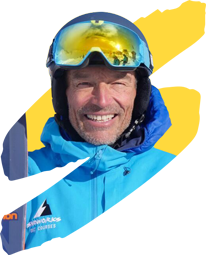
BCA Avalanche Bags Now Available On All Snoworks Off-Piste Courses
For this coming winter Snoworks have invested in 30 Airbags available for use on all Off-Piste, Backcountry, Backcountry Access and All-Terrain Courses.
They can be pre-booked and hired directly from Snoworks. Packs must be reserved in advance. Email [email protected] to reserve one.
Price: TBC
HISTORY OF OFF-PISTE SAFETY
Phil Smith, Director of Snoworks Ski Courses reports on the history of avalanche safety and what safety equipment to expect on a Snoworks Off-Piste Course.
Snoworks off-piste group. Tarentaise Backcountry Access March 2013
————————————-
1908 Avalanche Cords
It was as far back as the early 1900’s when avalanche safety first began with the use of avalanche cords. Developed by a Bavarian mountaineer named Eugen Oertel and they’re still in use today. The principle is simple. A long cord is attached to the person. Whilst skiing, snowboarding or walking the cord is dragged along behind. The assumption is that if the person gets buried in an avalanche, the light cord stays on top of the snow.
1968 Avalanche Transceivers
As long ago as 1968 the first avalanche transceiver, the Skadi, was created by a research team headed by John Lawton in New York. The Skadi was the first transceiver that could truly save lives. The first production units were sold in the early 70’s and the Skadi quickly became a standard item for workers at risk of snow avalanche burial, such as ski patrolers.
1973 RECCO
The Recco system was developed by Magnus Granhed, in Åre, Sweden, in 1973. Although avalanche transceiver were found to be most effective their disadvantage was the high cost, the need to turn them on and off and a requirement for batteries. This led Magnus to look at a reflector that could be carried by a skier at all times and rescuers could search for this with special equipment. Magnus formed Recco in 1980 and created a first prototype.
A small hand-held detector is carried by a rescuer, now standard issue with many ski resorts and mountain rescue teams. The reflectors are stitched into clothing and are currently used by over 200 makers of skiwear.
Gerald Kampel and Jürgen Wegner developed the ORTOVOX F2. Until then all avalanche transceivers would send and receive in different frequencies. The F2 could send and search on the same frequency. It soon became the number one avalanche transceiver on the market.
In those early days of off-piste safety it was common for only the leader and a backmarker to carry a shovel and probe. As long as the backmarker did not get buried and the leader was not too far down the mountain you were ok! However this was pretty basic safety so it was not long before it was normal practice for everyone skiing off-piste to wear a transceiver, know how to use it and carry a shovel and probe. Even now we still see skiers and groups of skiers with leaders venturing off-piste with none of this. Madness@*?
Snoworks introduced the compulsory use of transceivers, backpacks, shovels and probes on all off-piste courses. The Ortovox F1 was the preferred choice.
1996 ABS Airbag
Airbags had been around way before this but 1996 saw the introduction of the first ABS system with dual airbags. The entire fill procedure was changed and integrated into the pack. Both airbags were housed in the pack’s side pouches in order to leave more room available in the pack.
1997 First Digital Transceiver
The first digital transceiver was introduced by Backcountry Access under the brand name “Tracker”. The Tracker DTS soon became the most widely used transceiver in North America and is still sold and used by many backcountry enthusiasts. It was fast and easy to use. The Tracker DTS became the preferred choice for Snoworks. All off-piste courses now included the use of the Tracker DTS along with BCA Stashpack, shovel and probe.
2000 AvaLung
Denver psychiatrist Thomas Crowley began wondering what it would be like to be buried under an avalanche. He started tinkering with ways to survive one. After contemplating and then discarding several plans he hit on the solution whilst lying in bed. Why not design a device that could draw the air out of snow and then direct exhalations behind you? After several years of testing and perfecting Crowley’s invention which he named the AvaLung worked in a real avalanche, saving a backcountry skier.
2010 BCA Tracker 2
Snoworks replaces all it’s Trackers with the latest BCA Tracker 2, 22 litre stashpacks and new BCA shovels and probes. The Tracker 2 has the industry’s fastest, most precise pinpointing capability, with triple receive antenna, instantaneous real–time display and a user friendly interface.
2013 BCA Float 22
Snoworks introduce the availability of the BCA Float 22 Airbag System for hire on all Off-piste courses. A lightweight bag with enough volume to carry shovel, probe & personal items. Also features a dedicated shovel & probe pocket & user friendly ski carrying system.
The Airbags can be hired direct from Snoworks for substantially less than the price of airbag hire from most retail outlets.
Packs must be reserved in advance. Email [email protected] to reserve one.
Click for a list of all Snoworks Courses
Backcountry Access Float 22 Airbag System
avalanche (1) Backcountry (20) off-piste (22)
